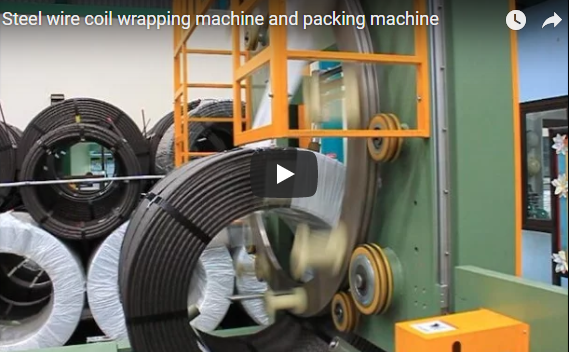Enhancing Protection and Efficiency: A Technical Look at Steel Wire Coil Wrapping Machines
Handling and packaging large, heavy steel wire coils present unique challenges in the manufacturing and logistics chain. Ensuring these coils reach their destination free from damage, corrosion, and contamination is paramount. A specialized steel wire coil wrapping machine provides an automated, efficient, and reliable solution for this critical task. These machines are specifically engineered to handle the significant weight and dimensions associated with products like PC wire, high-carbon steel wire, and other industrial wire types.
1. Understanding the Need for Specialized Wrapping
Steel wire coils are susceptible to various forms of damage during storage and transit:
- Environmental Factors: Moisture, dust, and contaminants can lead to rust and surface degradation.
- Handling Damage: Scratches, dents, and deformation can occur during movement with forklifts or cranes.
- Unraveling: Improperly secured coils can become loose, creating safety hazards and product loss.
Manual wrapping methods are often slow, inconsistent, labor-intensive, and pose ergonomic risks to workers dealing with heavy coils. Automated wire coil packaging machines address these issues directly.
2. Core Functionality and Wrapping Process
While specific designs may vary, the typical operational sequence of an automatic steel wire coil wrapping machine involves:
- Coil Loading: Coils are typically loaded onto the machine's infeed conveyor or directly onto the wrapping station's turntable/rollers, often using a C-hook, forklift, or integrated coil car.
- Centering (if applicable): Some systems automatically center the coil for uniform wrapping.
- Wrapping Cycle Initiation: An operator starts the cycle via an HMI (Human-Machine Interface), or the process begins automatically upon coil detection.
- Material Dispensing: The wrapping head (often orbital or ring-based) dispenses the chosen packaging material (e.g., stretch film, VCI paper).
- Rotation and Wrapping: The coil is rotated (either on rollers or a turntable) while the wrapping head applies the material around the coil's circumference and often through its inner diameter (eye). Overlap and tension are precisely controlled by the PLC (Programmable Logic Controller).
- Material Cutting and Sealing: Once the preset number of wraps is complete, the machine automatically cuts the wrapping material and secures the tail end (e.g., via heat sealing, clamping, or tucking).
- Coil Unloading: The fully wrapped coil is moved off the wrapping station via an outfeed conveyor or removed by handling equipment.
3. Key Technical Specifications and Features
When evaluating steel wire coil wrapping machines, consider these parameters:
- Coil Size Capacity:
- Inner Diameter (ID): Minimum and maximum eye size.
- Outer Diameter (OD): Minimum and maximum overall diameter.
- Width: Maximum coil width capacity (machines handling up to 800 mm or more are common for large wires).
- Weight: Maximum coil weight the structure and drives can support (often several metric tons).
- Wrapping Materials: Compatibility with various materials:
- Stretch Film (LLDPE - Linear Low-Density Polyethylene, standard or VCI-impregnated for corrosion inhibition).
- Paper (Kraft paper, VCI paper).
- Woven Plastic Fabric (HDPE/PP).
- Composite materials.
- Wrapping Speed/Cycle Time: Typically measured in coils per hour or seconds per coil, dependent on coil size and wrap pattern complexity.
- Rotational Speed: Speed of the turntable or drive rollers (RPM).
- Wrapping Head Speed: Speed of the material dispensing unit (RPM for orbital/ring wrappers).
- Overlap Control: Adjustable percentage of overlap between successive wraps.
- Film Tension Control: Adjustable tension for optimal load containment and material usage.
- Power Requirements: Voltage, phase, and power consumption.
- Control System: PLC-based controls with user-friendly HMI for parameter setting, diagnostics, and operation modes (manual/automatic).
- Construction: Heavy-duty, welded steel frame designed for industrial environments and heavy loads.
- Safety Features: Safety fencing, light curtains, emergency stops, interlocking access doors compliant with relevant safety standards.
4. Enhanced Benefits of Automated Wrapping
Investing in a robust steel wire coil wrapping machine offers significant advantages:
- Superior Product Protection: Consistent, tight wraps shield coils from moisture, dust, dirt, and physical damage. VCI materials add crucial anti-corrosion protection.
- Improved Operational Efficiency: Dramatically reduces wrapping time compared to manual methods, increasing throughput. Automates a repetitive, labor-intensive task.
- Increased Workplace Safety: Minimizes manual handling of heavy coils and awkward wrapping postures, reducing the risk of strains and injuries.
- Consistent Packaging Quality: Ensures every coil is wrapped to the same standard, improving load stability and visual presentation.
- Optimized Material Usage: Precise control over film tension and overlap minimizes material waste compared to manual application.
- Reduced Labor Costs: Frees up personnel for other value-added tasks.
5. Operational Considerations
To maximize the effectiveness of your wrapping machine:
- Material Selection: Choose the appropriate wrapping material based on the wire type, storage conditions, shipping duration, and required level of protection (e.g., VCI for susceptible steel).
- Parameter Settings: Optimize wrap counts, overlap percentage, and film tension for each coil type to ensure adequate protection without excessive material use.
- Operator Training: Ensure operators are properly trained on machine operation, safety procedures, and basic troubleshooting.
- Preventive Maintenance: Adhere to the manufacturer's recommended maintenance schedule for lubrication, inspection of moving parts (bearings, chains, belts), and sensor checks to ensure long-term reliability.
Conclusion
Heavy-duty steel wire coil wrapping machines are essential equipment in the modern wire production and processing industry. By providing consistent, efficient, and protective packaging, they safeguard product quality, enhance operational throughput, improve worker safety, and ultimately contribute to a more streamlined and cost-effective supply chain. Selecting the right machine with appropriate specifications and maintaining it properly ensures reliable performance for years to come.


